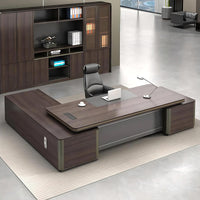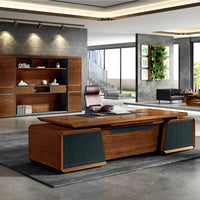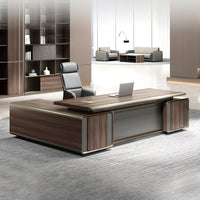Introduction to Conference Tables
kaguyasuContent Menu
● The Significance of Conference Tables
>> Enhancing Collaboration
>> Versatility and Customization
>> Technological Integration
● Types of Conference Tables
>> Rectangular Conference Tables
>> Round Conference Tables
>> Oval Conference Tables
>> Modular Conference Tables
● Design Considerations for Conference Tables
>> Material Selection
>> Size and Scale
>> Ergonomics
>> Sustainability
● Customization and OEM Services
● Benefits of OEM Services for Conference Tables
>> Brand Consistency
>> Quality Assurance
>> Cost Efficiency
● Conclusion
>> Frequently Asked Questions
In the realm of office furniture, conference tables play a pivotal role in facilitating communication and collaboration among team members. These tables are not just pieces of furniture; they are the epicenter of decision-making, brainstorming, and strategic planning. As a Chinese manufacturer specializing in the production and processing of conference tables, we cater to international brands, wholesalers, and manufacturers by offering OEM services. This article delves into the world of conference tables, exploring their significance, types, design considerations, and how they can enhance the productivity of any organization.

The Significance of Conference Tables
Enhancing Collaboration
Conference tables are designed to bring people together, fostering an environment conducive to open dialogue and teamwork. They provide ample space for participants to sit comfortably, allowing for face-to-face interactions that are essential for building trust and understanding among colleagues. In today's fast-paced business world, effective communication is key, and conference tables serve as the physical foundation for this process.
Versatility and Customization
One of the most appealing aspects of conference tables is their versatility. They can be customized to fit any office style, from modern minimalist designs to traditional wooden structures. This adaptability ensures that conference tables can seamlessly integrate into various corporate cultures, enhancing the aesthetic appeal of meeting rooms while maintaining functionality.
Technological Integration
Modern conference tables often incorporate advanced technology, such as built-in power outlets, USB ports, and cable management systems. These features enable seamless connectivity, allowing participants to charge their devices and access necessary data without cluttering the workspace. This integration of technology into conference tables further enhances their utility, making them indispensable tools for efficient meetings.
Types of Conference Tables
Rectangular Conference Tables
These are the most common type of conference tables and are ideal for formal meetings. Their rectangular shape allows for a structured seating arrangement, which can help maintain order during discussions. Rectangular conference tables are versatile and can accommodate a large number of participants, making them suitable for board meetings and large-scale presentations.
Round Conference Tables
Round conference tables promote equality and encourage participation from all attendees. They are often used in brainstorming sessions where every voice matters. The circular design eliminates the concept of a "head" of the table, fostering a more collaborative and democratic environment.
Oval Conference Tables
Oval conference tables offer a balance between the formality of rectangular tables and the inclusivity of round tables. They provide ample space for seating while maintaining a sense of intimacy, making them suitable for both formal and informal meetings.
Modular Conference Tables
Modular conference tables are highly flexible and can be rearranged to suit different meeting styles. They consist of multiple sections that can be combined or separated as needed, allowing for easy adaptation to changing meeting requirements.

Design Considerations for Conference Tables
Material Selection
The choice of material for conference tables can significantly impact their durability and aesthetic appeal. Common materials include wood, glass, and metal. Wooden conference tables offer a traditional look, while glass and metal tables provide a modern, sleek appearance.
Size and Scale
The size of a conference table should be proportional to the room and the number of participants it will accommodate. A table that is too large can overwhelm the space, while one that is too small may not provide enough room for all attendees.
Ergonomics
Ergonomic design is crucial for conference tables to ensure comfort during long meetings. The height and shape of the table should allow participants to sit comfortably with ample legroom and easy access to writing surfaces.
Sustainability
With the growing emphasis on environmental sustainability, conference tables made from eco-friendly materials are becoming increasingly popular. These tables not only reduce environmental impact but also contribute to a company's green credentials.
Customization and OEM Services
As a leading manufacturer of conference tables, we offer comprehensive OEM services that allow clients to customize their tables according to specific needs. Whether it's the shape, size, material, or technological features, our expertise ensures that each conference table is tailored to enhance the client's brand identity and office environment.
Benefits of OEM Services for Conference Tables
Brand Consistency
OEM services enable companies to maintain brand consistency by customizing conference tables that reflect their corporate image. This helps reinforce the brand's identity and values within the office space.
Quality Assurance
By partnering with a reputable manufacturer, clients can ensure that their conference tables meet high-quality standards. This includes durability, functionality, and aesthetic appeal, all of which contribute to a positive user experience.
Cost Efficiency
Customizing conference tables through OEM services can be more cost-effective than purchasing generic tables. Clients can specify exactly what they need, avoiding unnecessary features and reducing waste.
Conclusion
Conference tables are more than just pieces of furniture; they are central to the functioning of any organization. By offering OEM services for conference tables, we help businesses create meeting spaces that are both functional and reflective of their brand identity. Whether you're looking for traditional, modern, or technologically integrated conference tables, customization is key to maximizing their potential.
Frequently Asked Questions
1. What are the benefits of using wooden conference tables?
- Wooden conference tables offer a classic look and can add warmth to a meeting room. They are also durable and can be made from sustainable sources, making them an eco-friendly option.
2. How do I choose the right size for a conference table?
- The size of a conference table should be based on the number of participants it will accommodate and the dimensions of the room. Ensure there is enough space around the table for comfortable movement.
3. What are the advantages of modular conference tables?
- Modular conference tables are highly flexible and can be rearranged to suit different meeting styles. They allow for easy adaptation to changing meeting requirements, making them ideal for dynamic work environments.
4. How can I integrate technology into my conference table?
- Integrating technology into conference tables can be achieved by incorporating features such as built-in power outlets, USB ports, and cable management systems. These features enhance connectivity and reduce clutter.
5. What are the key considerations for designing an ergonomic conference table?
- Ergonomic design for conference tables involves ensuring the table height is comfortable for sitting, providing ample legroom, and facilitating easy access to writing surfaces. This helps reduce fatigue during long meetings.
6. How can OEM services benefit my business when purchasing conference tables?
- OEM services allow businesses to customize conference tables according to their specific needs, ensuring brand consistency, quality assurance, and cost efficiency. This helps reinforce the company's identity and values within the office space.











